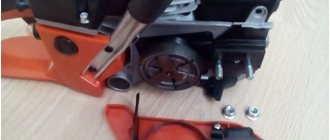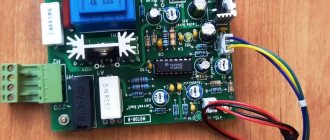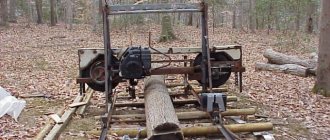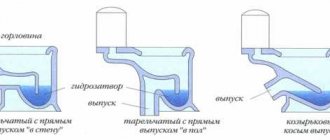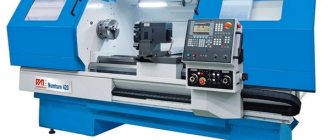Purpose of an electronic device for measuring revolutions
Using a tachometer, it is possible to find out the number of engine revolutions in one minute. It is a device that reads pulses from the spark plug insulator or high-voltage wire when sparking occurs. There is a microprocessor inside it that converts pulses into revolutions. All results are visible on the screen.
The main task of the tachometer is to accurately adjust the chainsaw carburetor in all operating modes: idle, maximum power.
When tuning “by ear”, without proper experience, you can exceed the maximum permissible engine speed, which will inevitably lead to increased wear of the engine and damage to its components. As a result, you can end up with serious and expensive piston repairs. In most modern chainsaws, the maximum speed recommended by the manufacturer ranges from 12-13 thousand.
For those who still want to set up a chainsaw carburetor without a tachometer, we strongly recommend reading the article about setting up a Chinese saw; it will warn you against serious mistakes.
This is what an overheated chainsaw piston looks like, which has collapsed as a result of overheating due to operation at speeds exceeding the maximum permissible.
Carburetor adjustment is necessary in the following cases:
- the chainsaw operates erratically;
- the saw immediately stalls after it is started;
- the saw does not start;
- idle speed is too high or too low;
- the carburetor has been repaired or has been replaced with a new one;
- fuel consumption has increased significantly;
- One or more adjustment bolts have become very loose.
The following are types of tachometers for chainsaws.
What are there and which one to buy - review of the 3 best from AliExpress
Tachometers can be wired or wireless. The latter are more expensive than the former.
If a wired type is used, then it is necessary to provide access to the high-voltage wire of the spark plug. The disadvantage of such devices is that it is necessary to remove the cover and air filter in order to have access to the wire. The connection can be made:
- Due to the clamp located at the end of the cord.
- Using a winding, which is fixed with insulating tape or a plastic clamp.
Tachometers without a wire connection are more convenient to use. This type of device allows you to measure engine speed at a distance of 15-20 cm from the insulating cap.
The main advantage of wireless devices is that when adjusting the carburetor, it is not necessary to dismantle the protective casing and air filter.
Below is an overview of the best brands of tachometers.
The cheapest without a crocodile - digital Kebidumei
This is the cheapest tachometer, it doesn’t even come with a crocodile, you just have to wind the wire instead. But the price is good.
The simplest tachometer, without a crocodile
The following functionality is worth noting:
- has a large LCD display;
- there is a reset function to zero hours;
- reads up to 10,000 hours, and then resets to zero;
- capable of counting up to 99,999 revolutions per minute;
- service time setting can be programmed;
- there is a reminder function to remind you to change the oil;
- This type of tachometer can work on all engines, the engine type can be selected using buttons S1 and S2;
- There is a splash protection function.
We recommend watching a video review of this tachometer, ordered from China; the author talks about the device in an interesting and detailed manner. He talks about the functionality, settings, disassembles the device itself to show what is inside and at the end shows an example of working on a gas mower (in principle there is no difference with a chainsaw).
The cheapest with a crocodile - Pulst Engine
This tachometer has the same characteristics as the previous one. It features richer equipment, or more precisely, the presence of a crocodile.
With more powerful functionality - Runleader
Thanks to a more powerful processor, it has better functionality, works faster, but also costs more. It looks more solid in your hands, the plastic is stronger, and the buttons are easier to press. The build is much better than the previous one. For frequent use it will be much better than the first option
Features worth noting:
- engine hour display function;
- can only be used with a gasoline internal combustion engine;
- To connect, you need to wind the contact wire around the spark plug wire. The wire length is 1.5 meters;
- The device does not work with 4-stroke engines, but it is not needed for chainsaws.
Homemade tachometer for chainsaw
This article will focus on a tachometer using a PIC controller PIC16F684. Information is displayed on an LED indicator module with a TM1637 chip. The input pulse shaper is implemented on the KR1006VI1 microcircuit. The schematic diagram of the device is shown in Figure 1.
The main element of the circuit is the PIC16F684 microcontroller. This controller is capable of functioning normally at a supply voltage of 3 volts, i.e. from two batteries of one and a half volts. In this case, the current consumption of the circuit is within six milliamps. The indicator module, implemented on the TM1637 chip, is also operational at a reduced supply voltage, although the brightness of the segments naturally decreases, but is sufficient for working with a tachometer.
At the input of the pulse shaper, made according to the classical scheme and implemented on the DA1 KR1006VI1 timer, counting pulses from the sensor are received through a differentiating chain - R1, C1. Diodes VD1 and VD2 protect the input of the microcircuit from excessive voltages and simultaneously release only positive pulses. The duration of the generated output pulse depends on the ratings of the RC chain R2 and C3. The time constant of this circuit is equal to the product of C by R = 10000 Ohm x 0.00000033 Ф = 3.3 milliseconds. Thus, the maximum frequency of input pulses should be no more than F = 1/T = 1/0.0033 ≈ 303Hz. For a two-stroke engine this will correspond to 303 x 60 ≈ 18181 rpm. Quite enough for us. From above, the numerical value of the revolutions is not limited by anything, so keep this in mind. Minimum speed = (1/65536 x2) x 60 = 457.76 ≈ 460 rpm. If the minimum speed is less than this value, then solid dashes will appear on the display. For my Husqvarna 395XP saw, the maximum speed is 12500. It was for this that I had to develop this circuit. The old woman sometimes requires repairs and maintenance, after all, it’s already 19 years old and she’s already sawed through kilometers of boards and bars, plus firewood. You can see my sawmill with this saw in “Homemade mobile sawmill.” And so, let's move on. If you experience errors in the indicator readings, you may have to install an additional quenching resistor in series with the input capacitor, the value of which you will select experimentally. When experimenting with my saw, I simply brought the wire with the “crocodile” 15 centimeters closer to the candle.
From the output of the driver, pin 3 of DA1, pulses are supplied to the RA2 input of the DD1 microcontroller. The engine crankshaft speed is calculated by measuring the repetition period of the input pulses from the sensor. The measurement is performed 16 times, then the arithmetic mean of the period is found. Next, the controller recalculates the period into revolutions per minute. Since I have a module with a “hour” indicator at my disposal, a colon is used to display tens of thousands of revolutions. For example, 12500 rpm will look like 12:50, less than 9999 rpm will be 9999 as usual.
When the device is turned on, segments D will be displayed on the indicator in all digits. When ignition pulses are applied to the input, the actual shaft rotation speed will begin to be displayed; after the signal is removed, the number of revolutions of the last measurement will remain on the indicator.
I don't have time to design and customize the case for this device, so everything was mounted in the case from an old lazy one. Unnecessary holes were simply sealed with duct tape and painted over with black paint. I think you will do better.
An ordinary “crocodile” was used as a pulse sensor. In real measurements there is practically no constancy of readings; this is due to the specifics of the operation of a two-stroke engine. Although, when pulses are supplied to the input from a generator with a frequency of 100 Hz, the indicator displays 6002 ... 6004 rpm.
That's all. Good luck. K.V.Yu.
Discuss this article on the “Radio electronics, questions and answers” forum.
Views:1 638
no comments
Tags: Homemade, Tachometer, digital, electronic
Which one should you choose?
If you need something cheaper, then you should take a closer look at the Kebidumei tachometer. If you plan to regulate the engine speed of the chainsaw, on average, at least once a month, then it is better to choose Runleader with more powerful functionality. For daily work, it is better to buy a non-contact laser tachometer WHDZ , although it is much more expensive, it will still improve labor productivity.
It doesn’t matter for which chainsaw you plan to use an electronic tachometer, be it the famous Shtil, Husqvarna or Russian Carver, any of the above will be suitable for all tools.
There are also more expensive tachometers for chainsaws, for example from such well-known brands as Shtil, but their prices are also steep, 7-10 times higher than top ones from China.
Stihl tachometer
How to use the Chinese Kebidumei tachometer?
Below are instructions for using an electronic tachometer using Kebidumei as an example:
- Before setting the operating mode of the device, the saw motor must be turned off.
- Turn on the device by pressing button S1.
- To select the operating mode of the device, you need to press the S1 button and hold it for 4 seconds. At this time, the display will display the following numbers: 01, 02, 03, 04. Information about the modes: 01 is intended for working with engines in which the pulse is applied to one spark plug once per operating cycle, symbol 02 - once per 2 operating cycles , 03 - once every 4 cycles of operation, value 04 - the tachometer function is disabled and the engine hour meter is turned on on the display.
- To activate the countdown mode until service, you must press and hold buttons 1 and 2 together for 4 seconds. Two segments with numbers from 00 to 09 will appear on the screen. They can be changed. The device automatically turns on the engine hour mode.
- To view the current time until service, you need to press and hold the S2 button.
- To reset the hour meter to zero values, you must press and hold the S1 button. You must hold the button above the date until the numbers 05 appear on the display.
How to properly adjust the carburetor?
In order to understand which screws are discussed below, read the article about adjusting the carburetor, it describes in detail the structure of the carburetor, its screws and the nuances of adjustment.
The carburetor in the chainsaw supplies the fuel-air mixture to the engine cylinder. Its adjustment is carried out as follows:
- When using a wired tachometer, remove the top protective cover of the saw body and, if necessary, the air filter. This is done in order to provide access to the high voltage spark plug wire. Wireless devices do not require these actions.
- Start the chainsaw.
- Connect the tachometer or bring the wireless device closer to the spark plug. It is enough to make 3-4 turns of the device wire around the candle.
- It is necessary to achieve the highest idle speed by turning screw L. Then you need to make 1/4 turn counterclockwise.
- If the chain moves in this mode, it is necessary to stop it by rotating screw T.
- Fully press the accelerator handle. The saw should operate in this mode for 10 seconds.
- Using screw H, set the maximum speed recommended by the manufacturer. Each chainsaw needs to set its own speed; usually this information is written in the operating or repair instructions. Let's give some approximate parameters using the Huter saw as an example. Idle speed: 3-3.2 thousand rpm, Maximum: 12.5 thousand rpm.
- Set the required idle speed using screw T.
- Make sure that the saw operates smoothly in all modes. To do this, you need to press and release the throttle.
- Disconnect the tachometer and replace the air filter and housing.
In order to remember the approximate factory engine speed, for clarity, look at the photo below.
Idle speed: 3000-3400 rpm. The main thing in this mode is that the engine runs stably and the chain stays in place. Maximum speed: 12000-13000 rpm. Exceeding is not permissible; if lower, the power will be reduced.
When adjusting a chainsaw carburetor
The chainsaw operates using a two-stroke internal combustion engine. Such a motor provides the tool with two important advantages - mobility and a high degree of performance. The fuel-air mixture is supplied to the engine cylinder via a carburetor. This carburetor needs adjustment or adjustment when:
- Attempts to start a gas-powered tool lead to unsatisfactory results.
- Engine operation is unstable (revolutions decrease and the engine stalls)
- Floating speed occurs at idle
- From the first seconds of starting the engine it stalls
- The petrol tool engine was overhauled
- The carburetor has been repaired or cleaned
- Gasoline tools are being run-in
A tachometer for a chainsaw is needed for running in the tool, since it is used to adjust the carburetor. Its setting using the device becomes more accurate, which has a positive effect on the operation and performance of the unit
How to make a revolution counter with your own hands?
Anyone with basic knowledge of electronics can assemble a tachometer for a chainsaw with their own hands. You can view and download the diagram below. To assemble a simple pointer device you will need:
- Pointer indicator. It can be taken from a tape recorder (mA in the diagram).
- Fixed 10 kOhm resistor (R1 in the diagram).
- 20 kOhm variable resistor (R2 in the diagram).
- Voltage transformer.
- 4 semiconductor diodes for converting voltage from a transformer.
- Capacitor 470 mF (C1 in the diagram).
- Wires.
Instructions on how to assemble a homemade tachometer:
- You can assemble a tachometer according to the diagram on any piece of plastic.
- Make holes in the board for parts.
- Install all device components on the board in accordance with the diagram.
- Remake the scale, making divisions on it every 500 rpm. / min. with an interval of 10 mm.
A simple tachometer circuit for measuring the engine speed of a chainsaw.
Adjust the assembled device together with a reference device.
If you need a more accurate measurement, it is better to use a ready-made device.
How to make a tachometer for a chainsaw with your own hands
Making a tachometer for a chainsaw with your own hands is rational only if there is a single need for its use. If you are a regular owner of gas-powered tools, then it is recommended to acquire a factory-made device. Multifunction multimeters have a frequency measurement mode that can be used to calculate revolutions.
You can make the device yourself, but for such purposes you will need a soldering iron and some electronic consumables: resistors, diodes, capacitors. The head from a tape recorder is used as a speed indicator.
Making a tachometer from a measuring head from a tape recorder
The video shows the finished device in action. The only drawback of such a device is low accuracy, as well as the need to calculate the number of revolutions, since the device displays decibels.
If you need to get the most accurate results for setting up a chainsaw, then experts recommend using factory tachometers (even if they are of Chinese origin).
Summing up
The tachometer is a useful device; it allows you to fine-tune the chainsaw carburetor, as well as check whether the current idle speed and maximum speed settings correspond to the factory ones. In case of deviation, identify the malfunction in time and eliminate it.
It is worth remembering that if the carburetor adjustment is violated, the maximum speed may increase (more than 13 thousand) , above the permissible value, which in turn will lead to damage to the saw engine. A person will not hear this by ear, but the tachometer will allow you to see it.
Source
Tachometer for chainsaw. How to adjust a chainsaw carburetor using a tachometer
Hand chainsaws are currently widely used both for felling trees, cutting branches and further collecting firewood, and in the construction of wooden houses and various buildings for household purposes. Like any other tools, these devices (quite reliable) require regular maintenance and sometimes adjustment. For example, a tachometer for a chainsaw will allow you to easily not only check the characteristics of a newly purchased tool, but also make subsequent adjustments to the carburetor yourself.
Tachometer for chainsaws and carburetor settings
The popularity of hand chainsaws is quite high, so they are used not only for work in the forest, but also in the household, for example, for pruning trees. They have many advantages, among which it is important to highlight mobility, reliability, and long service life. Although the last point depends not only on the quality of the tool, but also on the nature of its operation. The nature of operation includes not only compliance with the correct sawing technology, but also ensuring the care of the tool. In particular, starting to use a new chainsaw requires a break-in, after which you may need to adjust the carburetor. For such purposes, you will need a tachometer for a chainsaw.
The principle of operation of a tachometer for a chainsaw
A tachometer is a device that measures the number of engine revolutions in one minute. It is almost impossible to connect a mechanical device to a tool with a gasoline engine (and it is not necessary). A modern tachometer for a two-stroke chainsaw engine is a digital device that reads pulses from a spark plug insulator or high-voltage wire at the moment of spark formation (without direct contact). The built-in microprocessor converts the pulses into engine speed. The readings are displayed on an easy-to-read LCD display. Depending on the manufacturer and design features, the price of such devices varies from 950 to 6,500 rubles.
How to make a digital tachometer with your own hands
Devices of this type have an identical purpose, but differ in structural elements. To build the device yourself, you will need the following parts:
- The converter is eight-bit.
- A processor that allows you to convert pulses into a chain of zeros and ones.
- Display for showing readings.
- Interrupting type device (rotation controller) with amplifier. Special shunts may be used for this purpose, depending on the specific situation.
- Payment for resetting information.
- Additionally, you can connect to the processor a temperature controller for antifreeze, cabin air, engine fluid pressure, and the like.
- To set up the normal operation of the device, you will need to install a special program.
Wired tachometers for chainsaws
The most common devices for monitoring chainsaw engine speed are models with a wired connection. Their popularity is due to their low price. Various models of electronic tachometers for chainsaws from the Chinese manufacturer Runleader now cost 950-1850 rubles.
To measure engine speed with such a device, it is necessary to provide access to the high-voltage spark plug wire, which (depending on the model) can be connected in two ways:
- using the clamp located at the end of the cord included in the kit;
- using a winding (5-6 turns of the free end of the cord around a high-voltage wire), fixed with a plastic clamp or insulating tape.
Types of tachometers for chainsaws
In order to adjust the carburetor, wired devices are used, since they are several times cheaper than wireless ones. Wired devices are connected to the high-voltage wires of the instrument (for which there are special clamps) by wrapping them with 5-6 turns. Instructions are included with the device, so you should read it before use.
The disadvantage of wired devices is the need to remove the cover and air filter to get to the high-voltage wire. Wireless devices that measure shaft rotation speed even at a distance of 15-20 cm from the motor do not have this drawback.
If you know how to adjust the carburetor on a tool, you will not need to contact service centers. It is strongly recommended that you carry out the first setup according to the instructions, so that all subsequent times you can perform the procedure yourself without the help of specialists.
Wireless engine speed meters
More convenient to use are tachometers for chainsaws, which allow you to control engine speed without connecting a wire. Such measuring instruments measure engine speed at a distance of 15-20 cm from the insulating cap of the spark plug. The undoubted advantage of such measuring devices is that when adjusting the carburetor there is no need to dismantle the protective casing and air filter. But these devices are much more expensive than their wired counterparts.
On the Russian market, the most affordable wireless tachometers are from the leading ones and Shtil: Husqvarna PET-302 and Stihl EDT-9.
These devices are quite versatile. Measurements can be taken at different distances from the spark plug cap:
- at a distance of 5-10 cm, when using only the device itself;
- 15-20 cm by connecting a short antenna wire (15 cm long) to the device;
- 1.2 m, using a measuring cord with a clamp for attaching to the high voltage wire of the spark plug.
In what cases is it necessary to adjust the chainsaw carburetor?
Along with such preventive maintenance as replacing spark plugs, fuel or air filters, the need to adjust the chainsaw carburetor periodically arises. This must be done when:
- the new chainsaw operates unstably on the fuel available to the user;
- the saw does not start;
- idle speed is too high or too low;
- the saw starts and immediately stalls;
- fuel consumption declared by the manufacturer has increased significantly;
- when one or more adjusting bolts are loosened;
- after repairing the carburetor or replacing it with a new one.
What to pay attention to before starting adjustment work
Before starting any adjustment work, you must carefully read the instructions for the chainsaw. It indicates the engine speed (at idle and the maximum permissible) that must be set when adjusting the carburetor for the correct operation of the tool. The period of uninterrupted operation largely depends on this.
The air filter must be thoroughly cleaned or replaced. You should also make sure that the spark plug is in good condition and that the required gap between the electrodes is set.
Important! Before setting up, warm up the saw at idle speed for 8-12 minutes.
Setting up carburetors for low-power chainsaws
Low-power chainsaws (for example, the quite popular MS170 and MS180 models from Stihl with an engine capacity of 30-32 cm³) are usually equipped with carburetors with only one adjusting screw.
On the body it is designated by the Latin letters LD. It is designed to adjust engine speed in idle mode. Setting up such a carburetor can be done either with or without a tachometer to measure the speed of the chainsaw:
- tighten the adjusting bolt until it stops;
- unscrew it two turns;
- we start the chainsaw.
If the idle speed is too low (this is indicated by the tachometer readings or unstable engine operation), then turn the screw until the saw chain begins to move. Then unscrew it ½ turn back (that is, in the opposite direction).
If the idle speed is too high and the chain begins to move immediately after starting the engine, then turn the screw until it stops and make another ½ turn in the same direction.
Regulation rules
The carburetor adjustment diagram and the recommended position of the adjusting screws are indicated in the instructions for each specific tool. When getting acquainted with a new saw, it is recommended to tighten the screws all the way, counting the number of revolutions, so that later you can return the factory settings. The general principles of adjustment are as follows:
— Before adjusting, the engine must be warmed up at idle speed for 10 minutes.
— By rotating the screw L (see the beginning of the article), you need to achieve such a mixture quality that at idle the engine runs evenly at 1500–2000 rpm. In this case, acceleration (acceleration) when pressing the accelerator lever should be fast, but uniform. A dip in the speed increase indicates that the mixture is too lean; the screw must be unscrewed until this phenomenon disappears.
— After adjusting the mixture for low speeds, screw T is tightened until the chain begins to rotate, and then backed out 1/2. 1/3 turn. Here it is important to monitor the serviceability of the clutch mechanism.
— The H screw is not adjustable in home-made conditions.
The danger of independently adjusting screw H is that too lean a mixture at high speeds, and especially under load, leads to rapid wear of the piston and failures in the ignition system. You can attempt to adjust high speeds only if three conditions are met:
— The chainsaw obviously does not produce the required power when sawing.
— The person performing the adjustment has general knowledge of the structure of carburetor engines.
— A means of measuring engine speed is available.
The latter can be either a tachometer or a multimeter with a built-in oscilloscope. To connect the multimeter, you need to wrap 3-4 turns of thin copper wire around the spark plug wire.
The main task of screw H is to compensate for over- or under-revving due to a change in fuel type, oil concentration or air composition. Also, the “upper” setting can be disrupted by insufficient precision in adjusting the low speed screw. The adjustment scheme is simple - the screw is tightened or unscrewed until the saw engine at maximum gas produces 14.5–15 thousand rpm or the value specified in the operating instructions.
If you use a cz oscilloscope, its readings (spark discharge frequency) should be in the region of 230–250 Hz. Take into account the accuracy class of the measuring instruments and the fact that under load the speed drops by 10–15%. It is better if the engine runs at low speeds than at high speeds, even if only slightly.
Adjusting the chainsaw carburetor using a tachometer
The largest number of chainsaws "Husqvarna", "Shtil", 'Partner', "Champion" (as well as from numerous Chinese manufacturers) have three spring-loaded adjusting screws on the carburetor.
They are designated by Latin letters and are intended:
- L – to regulate fuel supply at low speeds.
- H – to set the amount of fuel at maximum speed.
- T (for some LA models) – decrease or increase the supply of the air-fuel mixture at idle.
To carry out the work, you will need a thin slotted screwdriver and a tachometer to adjust the chainsaw.
On a note! To make it easier to count the revolutions of the adjusting screws, it is better to apply a clearly visible mark on the handle of the screwdriver in advance.
The setup algorithm is quite simple:
- If you have a wired tachometer, remove the protective casing and air filter to provide free access to the high-voltage wire. This is not necessary when using a wireless meter.
- We start the chainsaw.
- We connect the tachometer (or bring the wireless device close enough to the spark plug).
- By rotating screw L we achieve the highest idle speed. Then make ¼ turn counterclockwise.
- If the chain moves in this mode, then by rotating the screw T (LA) we achieve its complete stop.
- Press the accelerator handle all the way.
- Let the saw work in this mode for 8-10 seconds.
- Based on the tachometer readings, use screw H to set the maximum speed recommended by the manufacturer.
- Using the adjusting bolt T, set the required idle speed.
- By pressing and releasing the gas handle, we make sure that the tool operates smoothly in all modes, without dips or jerks.
- Turn off the tachometer.
- Reinstall the air filter and protective cover.
In what cases will carburetor adjustment be required?
The design of the chainsaw is equipped with a two-stroke gasoline engine, which is a rather complex device. One of the key elements of the internal combustion engine is the carburetor, the settings of which will determine the performance of the tool. Carburetor adjustment is necessary in the following cases:
Adjustment will also be required in order to run-in the tool. To fine-tune the carburetor, it is recommended to use a chainsaw tachometer. We will find out further what the work of adjusting the carburetor using a special device is.
How to adjust a chainsaw carburetor using a tachometer
Almost all types of chainsaws in the carburetor design are equipped with three adjusting screws. Each has a corresponding designation and purpose. These designations include:
To adjust these screws you will need thin screwdrivers as well as a tachometer. The principle of carburetor regulation is to perform the following actions:
At the end of the work, turn off the tachometer and install the filter and cover in place.
Types of measuring instruments
To adjust the carburetor of chainsaws, they mainly use wired tachometers, since they are much cheaper than wireless ones and allow more accurate results to be obtained. The estimated cost of wired tachometers is 1000 rubles. The devices are connected to a high-voltage wire, which is ensured by means of a special clamp or by wrapping it with 5-6 turns.
Wireless devices also have a number of advantages, but the main one is the ability to take measurements without removing the cover and filter. Such models of devices allow measurements at a distance of up to 15-20 cm.
To carry out carburetor adjustment work, you can also use a homemade tachometer. You can do it yourself, but to do this you will need to be familiar with electronics. Making a tachometer with your own hands does not make sense, since it is much easier to purchase a factory product. The use of such a reliable assistant when tuning a chainsaw will allow you to obtain its maximum performance.
Source
